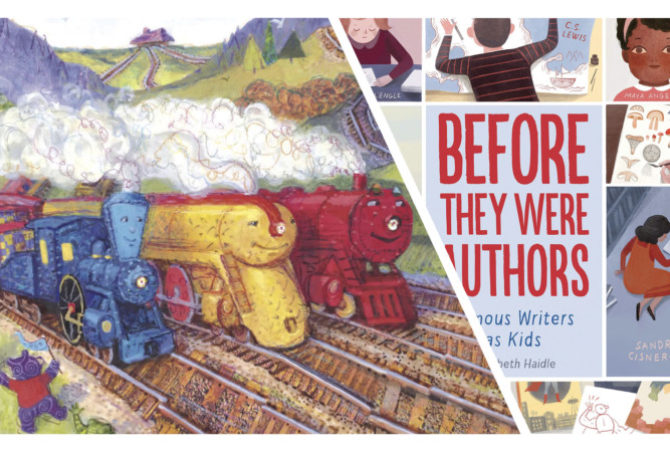
Illustrated children’s books aren’t meant just for children. They convey messages as appropriate for adults as children. And they prove the power of visual storytelling.
Two good examples are Before They Were Authors by Elizabeth Haidle and Three Little Engines by Bob McKinnon. Haidle’s book traces the origin stories of 10 famous authors, from Mark Twain to J.K. Rowling, and their challenges from childhood to best-selling writers. McKinnon retells The Little Engine That Could with a different message about fortitude.
Before They Were Authors portrays how young people from diverse backgrounds overcame obstacles to turn their love of writing into life-changing careers. Three Little Engines shows how fortitude can coexist with collaboration.
Both books are richly illustrated to entrance young as well as older eyes. Haidle offers charming portraits of each author as a child. McKinnon’s illustrations underscore his theme of people helping people and making a difference in their lives.
Each book tells a powerful story. Haidle traces C.S. Lewis’ fascination as a child with magical gardens to his written wonderlands. Maya Angelou overcame the divorce of her parents and stuttering to reinvent herself as an actress, poet and civil rights activist. Sandra Cisneros, a Mexican immigrant living in Chicago, wrote poetry in secret until a high school teacher discovered and nurtured her talent. J.K Rowling grew up in a home teeming with with books, but found her inspiration of wild things from what she saw wandering near her cottage home.
The temptation is to believe “picture stories” are just for kids. However, just as comic books have expanded their appeal to adults, visual storytelling is not limited to children’s books.
In The Little Engine That Could, a long train carrying toys for kids breaks down. Pleas to bigger, more powerful trains are rebuffed. Instead, a smaller train agrees to try and, against all odds, succeeds in climbing a mountain with the load of toys, coining the phrase, “I think I can. I think I can. I think I can.” as well as “I thought I could. I thought I could. I thought I could.”
McKinnon retools the story so all the trains cooperate to bring home the trainload of toys. “Have you ever asked yourself ‘How did I end up here?’ What experiences and circumstances have led to where I am right now?” is the challenge McKinnon issues to her young and old readers. Before writing the original draft of his book in one sitting, McKinnon says he made a list of all the people who had influenced his life. “It was a really long list.”
The themes of both books are at once easy to understand, yet complex in their meaning. They offer a lot to digest for young people looking ahead and older people looking back. Both books are layered and nuanced, while captivating in the simplicity of their visual explanations. Their messages have deep resonance: If you want to write, read. If you want to succeed, help others.
The temptation is to believe “picture stories” are just for kids. However, just as comic books have expanded their appeal to adults, visual storytelling is not limited to children’s books. Telling stories visually offers an opportunity to share more detail and context economically than verbal explanations can. Visual storytelling can attract attention and hold it better than a typical paragraph of words.
Telling visual stories may seem daunting. Haidle’s observation should be reassuring, “All famous authors were once ordinary kids who felt that the writing of tales was something that couldn’t live without.” You don’t have to be a famous author to have training as a kid in how to draw a picture, whether it is realistic or fantastical. Most of us have been scribbling and drawing since we were old enough to pick up a crayon. That’s actually all the credentials and inspiration you need to become a visual storyteller.
As you learned as a child, all you need to start is an idea. Develop it anyway you can, even with stick figures or inspiration images gleaned from the internet. Find help and collaborate, like the three engines working together to haul toys over a mountain. Haidle and McKinnon teamed with illustrators on their books. They also had editors and possibly gentle reviewers to offer comments and suggestions.
Visual storytelling is about stories that can’t wait to be seen. Your job is to help them be seen.




